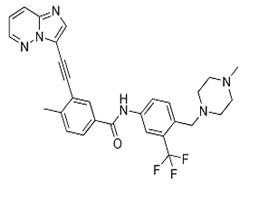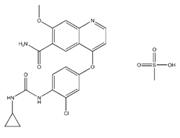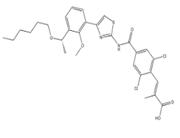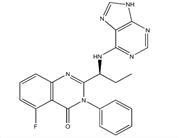| Anticancer drug |
Ponatinib is an anticancer drug. It was approved by the FAD and entered into market in 2012 12 for the treatment of adults with chronic myeloid leukemia (CML), "Philadelphia chromosome positive" (Ph +) and acute lymphoblastic leukemia (ALL). It is mainly used for the treatment of patients who have failed to get any response from dasatinib or nilotinib therapy or are intolerant to dasatinib or nilotinib and patients who are not suitable for being subject to follow-up treatment of imatinib. It can also be used for treating patients with a gene mutation ("T315I mutation ') which makes the patients be resistant to the imatinib, dasatinib or nilotinib. It can also be used for the treatment of adults have not used other TKIs treatment of CML and Ph + ALL. It is the only market drug which is effective in treating the T3151 mutation of the Bcr-Abl kinase Ponatinib has been approved by the EU centralized procedure in July 2013.
Ponatinib is the third generation multi-targeted tyrosine kinase inhibitor. Typical multi-targeted tyrosine kinase inhibitor drugs include Sunitinib, imatinib, sorafenib and vatalanib.
On November 22, 2013, the European Medicines Agency (EMA) announced that due to the risk of Ponatinib of causing fatal blood clots and serious vascular stenosis. The Committee for Medicinal Products (CHMP) of has proposed for renewing the usage recommendations of Ponatinib to help patients minimize the risk of blood clot blocking artery or vein.
The above information is edited by the chemicalbook of Dai Xiongfeng. |
| Pharmacological effects |
Ponatinib can effectively inhibit the in vitro kinase activity of FGFR1-4 with the IC50 values being 2,2,18 and 8nmol/L, respectively. In the cells without interleukin-3, the IC50 values of Ponatinib for inhibition of cell FGFR1-4 kinase were 24, 8, 8 and 34nmol/L. It has been also detected in every cell of the inhibitory effect of Ponatinib in inhibition of the FGFR1-4 phosphorylation with the IC50 values being 39, 29, 32 and 39 nmol/L. It has been also detected of its inhibitory effect on the FGFR in multiple endometrial, bladder, stomach and thymus cells. Compared with other drugs, Ponatinib showed significant pharmacological effects. For example, its effect of inhibiting the endometrial AN3CA and MFE-296 cell proliferation and GI50 value is 14 and 61nmol/L, respectively. This has shown that Ponatinib is a kind of powerful FGFR inhibitors. In mouse tumor xenograft model, for a daily dosage of 10mg/kg or 30mg/kg, the tumor inhibition rates were 49% and 82%.
Ponatinib can inhibit all the BCR-ABL mutants in the detection and inhibit the BCR-ABLT315I of tumor cells inside mice body and is an extensively active BCR-ABL inhibitor in the treatment of chronic myeloid leukemia. Ponatinib can inhibit both the BCR-ABL and their related mutants expressed by the growing cells. Have Ponatinib acted on the monocytes of the leukemia patients can lead to a number which is at least 500 times smaller than normal cells. Ponatinib can also inhibit the BCR-ABLT315I kinase activity and the colony formation of primary chronic myelogenous leukemia cell with SRC, FGFR, VEGFR and PDGFR family kinase being the potential targets for a variety of malignant tumors. Ponatinib can inhibit these kinds of kinase and would be a widespread drug for cancer treatment.
Ponatinib is not only clinically effective in inhibiting the BCR-ABL itself and its mutant with clinical effective drug concentrations and can also effectively inhibit FLT3, KIT, fibroblast growth factor receptor 1 (FGFR1) and platelet-derived growth factor receptor α (PDGFRα) activity in vitro. Using these leukemia cell lines containing the active form of these receptors for cell line experiments, we found that it can effectively inhibit the phosphorylation of the receptor and proliferation of cells with the activity of Ponatinib in inhibiting the FLT3-ITD mutant in the acute myeloid leukemia patients reaching 30%. In the MV4-11 (FLT3-ITD+/+) acute myeloid leukemia cells, ponatinib, can suppress the FLT3 signal and induce apoptosis in concentration being less than 10nmol/L. In the MV4-11 mouse xenograft model, ponatinib can enable tumor regression in a dose-dependent manner. In the first phase of clinical trials, Ponatinib has successfully inhibited the BCR-ABL mutation function of refractory patients with chronic myeloid leukemia. From the significance in the change of the morbidity and FLT-ITD can show that the role of this enzyme in leukemia pathogenesis. Preclinical studies have shown that FLT3 inhibitors can be used to kill FLT3-dependent leukemia cells. |
| Toxic side effect |
The ponatinib instruction has black box warning, warning that it has risk of causing blood vessel blockage, heart failure and liver toxicity. The most common non-hematologic adverse reactions (≥20%) of ponatinib include high blood pressure, rash, abdominal pain, fatigue, headache, dry skin, constipation, joint pain, nausea and fever. Hematologic adverse events include thrombocytopenia, anemia, neutropenia, lymphopenia and leukopenia. |
| Standard dose |
The recommended dose of ponatinib is 45mg/d and should be subject to oral administration. |
| Drug Interactions |
CYP3A4 enzyme can promote the metabolism of ponatinib. So during the treatment, we should avoid using potent CYP3A4 inhibitors. Information related to the pharmacological effects, side effects, drug contraindications, etc of ponatinib is edited by Shiyan from Chemicalbook. (2015-10-23) |
| Drug contraindications |
It has no drug contraindications but patients of liver dysfunction, cardiac dysfunction and thrombosis should take with caution. |
| Chemical Properties |
Pale Yellow Solid |
| Uses |
AP24534 is a novel potent, orally available small molecule multitargeted kinase inhibitor with IC50 of 0.37, 2, 1.5, 2.2, 1.1, 1and 0.24 nM for native pan-BCR-ABL, mutated form, VEGFR2, FGFR1, PDGFRα, mutant FLT3 phosphorylation and LYN. |
| Uses |
Ponatinib (AP24534) is a novel potent, orally available small molecule multitargeted kinase inhibitor. Ponatinib inhibits both native and mutant BCR-ABL. Ponatinib is used in the treatment of chronic myeloid leukemia (CML) with BCR-ABL kinase inhibitors. |
| Uses |
Ponatinib (AP24534) is a novel, potent multi-target inhibitor of Abl, PDGFRα, VEGFR2, FGFR1 and Src with IC50 of 0.37 nM, 1.1 nM, 1.5 nM, 2.2 nM and 5.4 nM, respectively |
| Definition |
ChEBI: A benzamide obtained by the formal condensation of the carboxy group of 3-(imidazo[1,2-b]pyridazin-3-ylethynyl)-4-methylbenzoic acid with the anilino group of 4-[(4-methylpiperazin-1-yl)methyl]-3-(trifluoromethyl)aniline. |

 China
China






